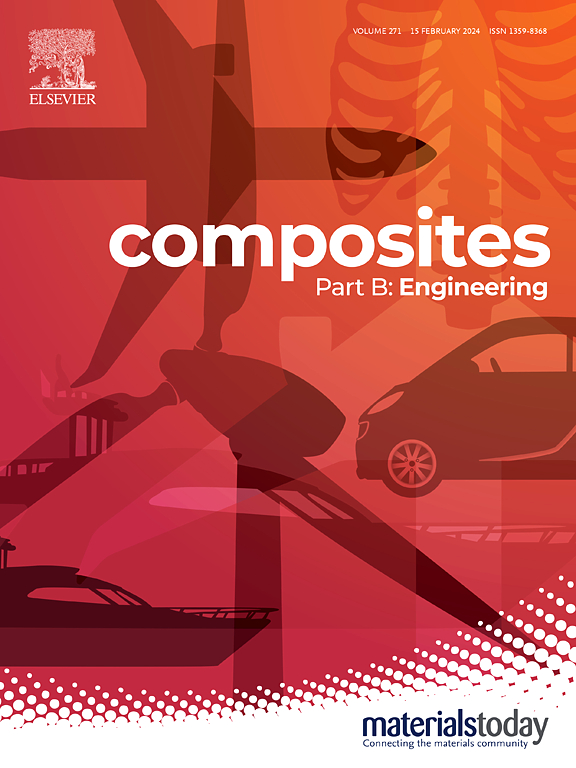Indentation hardness and sliding wear of carbon fiber reinforced polymer (CFRP) resulting from the effects of adhesive film and additional thermal treatment
IF 12.7
1区 材料科学
Q1 ENGINEERING, MULTIDISCIPLINARY
引用次数: 0
Abstract
The primary objective of this study is to determine the optimal CFRP (Carbon Fibers Reinforced Polymer) structure with the most favourable mechanical and tribological properties for high-performance applications. The novelty of this work lies in the comprehensive analysis of the combined effect of adhesive film (AF) layers and additional annealing on the indentation hardness and sliding wear resistance of CFRP laminates. Although previous studies have investigated the tribological behaviour of CFRPs, our research uniquely evaluates how polymeric adhesive films, in conjunction with thermal treatment, influence structural integrity and wear resistance.
This study specifically examines the role of different AF layers in friction resistance and wear mechanisms, which are crucial for applications involving high-stress sliding contact. Furthermore, a novel approach is presented to assess the effect of post-curing at elevated temperatures (140 °C) on the mechanical properties of CFRPs, particularly hardness and elastic modulus, which are critical for structural applications. By systematically comparing different laminate configurations and their response to sliding friction, this research contributes to the development of more durable and wear-resistant CFRP-based components for the aerospace and automotive industries. The novelty of this work lies in the comprehensive analysis of the combined effect of adhesive film (AF) layers and additional annealing on the indentation hardness and sliding wear resistance of CFRP laminates.
碳纤维增强聚合物(CFRP)的压痕硬度和滑动磨损是由粘接膜和附加热处理的影响造成的
本研究的主要目的是确定具有最有利的机械和摩擦学性能的高性能应用的最佳CFRP(碳纤维增强聚合物)结构。本工作的新颖之处在于综合分析了粘接膜(AF)层和附加退火对CFRP复合材料压痕硬度和滑动耐磨性的综合影响。虽然之前的研究已经调查了cfrp的摩擦学行为,但我们的研究独特地评估了聚合物粘接膜与热处理如何影响结构完整性和耐磨性。本研究特别研究了不同AF层在摩擦阻力和磨损机制中的作用,这对于涉及高应力滑动接触的应用至关重要。此外,提出了一种新的方法来评估高温(140°C)后固化对cfrp机械性能的影响,特别是硬度和弹性模量,这对结构应用至关重要。通过系统地比较不同的层压板结构及其对滑动摩擦的响应,本研究有助于为航空航天和汽车工业开发更耐用、更耐磨的cfrp基组件。本工作的新颖之处在于综合分析了粘接膜(AF)层和附加退火对CFRP复合材料压痕硬度和滑动耐磨性的综合影响。
本文章由计算机程序翻译,如有差异,请以英文原文为准。
求助全文
约1分钟内获得全文
求助全文
来源期刊

Composites Part B: Engineering
工程技术-材料科学:复合
CiteScore
24.40
自引率
11.50%
发文量
784
审稿时长
21 days
期刊介绍:
Composites Part B: Engineering is a journal that publishes impactful research of high quality on composite materials. This research is supported by fundamental mechanics and materials science and engineering approaches. The targeted research can cover a wide range of length scales, ranging from nano to micro and meso, and even to the full product and structure level. The journal specifically focuses on engineering applications that involve high performance composites. These applications can range from low volume and high cost to high volume and low cost composite development.
The main goal of the journal is to provide a platform for the prompt publication of original and high quality research. The emphasis is on design, development, modeling, validation, and manufacturing of engineering details and concepts. The journal welcomes both basic research papers and proposals for review articles. Authors are encouraged to address challenges across various application areas. These areas include, but are not limited to, aerospace, automotive, and other surface transportation. The journal also covers energy-related applications, with a focus on renewable energy. Other application areas include infrastructure, off-shore and maritime projects, health care technology, and recreational products.
 求助内容:
求助内容: 应助结果提醒方式:
应助结果提醒方式:


